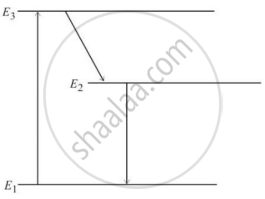Advertisements
Advertisements
प्रश्न
Find the maximum potential difference which may be applied across an X-ray tube with tungsten target without emitting any characteristic K or L X-ray. The energy levels of the tungsten atom with an electron knocked out are as follows.
| Cell containing vacancy | K | L | M |
| Energy in keV | 69.5 | 11.3 | 2.3 |
उत्तर
Let the potential required that may be applied across the X-ray tube without emitting any characteristic K or L X-ray be V.
∴ Energy of electron = eV
This amount of energy is equal to the energy of L shell.
So, the maximum potential difference that can be applied without emitting any electron is 11.3 kV.
APPEARS IN
संबंधित प्रश्न
Why are microwaves considered suitable for radar systems used in aircraft navigation?
Identify the part of the electromagnetic spectrum which is:
produced by bombarding a metal target by high speed electrons.
State the approximate range of wavelength associated with the ultraviolet rays.
Name three properties of ultraviolet radiations which are similar to visible light.
An electromagnetic wave has a frequency of 500 MHz and a wavelength of 60 cm.name the medium through which it is travelling
If the potential difference applied to the tube is doubled and the separation between the filament and the target is also doubled, the cutoff wavelength
Cutoff wavelength of X-rays coming from a Coolidge tube depends on the
(a) target material
(b) accelerating voltage
(c) separation between the target and the filament
(d) temperature of the filament.
Name the scientist who discovered Ultraviolet rays
To which regions of the electromagnetic spectrum do the following wavelengths belong:
(a) 250 nm
(b) 1500 nm
Calculate the shortest wavelength of electromagnetic radiation present in Balmer series of hydrogen spectrum.
Name the radiation of the electromagnetic spectrum which is used for the following:
To photograph internal parts of the human body and Give the frequency range
How will you investigate the existence of the radiation beyond the red and violet extremes of the spectrum?
State three properties of infrared radiations similar to that of visible light.
Choose the correct option.
How does the frequency of a beam of ultraviolet light change when it travels from air into glass?
Answer briefly.
Name the most harmful radiation entering the Earth's atmosphere from outer space.
Name the e.m. waves which are suitable for radar systems used in aircraft navigation. Write the range of frequency of these waves.
A car is moving towards a high cliff. The car driver sounds a horn of frequency f. The reflected sound heard by the driver has a frequency 2f. If v be the velocity of sound, then the velocity of the car, in the same velocity units, will be:
The electric field intensity produced by the radiations coming from 100 W bulb at a 3 m distance is E. The electric field intensity produced by the radiations coming from 50 W bulb at the same distance is ______.
Write two uses of the following radiation.
X-rays
In an atom X, electrons absorb the energy from an external source. This energy “excites” the electrons from a lower-energy level to a higher-energy level around the nucleus of the atom. When electrons return to the ground state, they emit photons.
The figure below is the energy level diagram of atom X with three energy levels, E1 = 0.00eV, E2 = 1.78eV and E3 = 2.95eV. The ground state is considered 0 eV for reference. The transition of electrons takes place between levels E1 and E2.

- What wavelength of radiation is needed to excite the atom to energy level E2 from E1?
- Suppose the external source has a power of 100 W. What would be the rate of photon emission?
